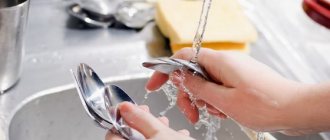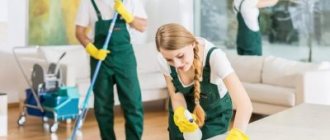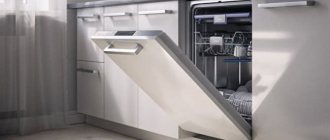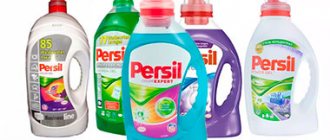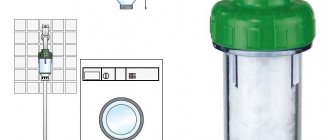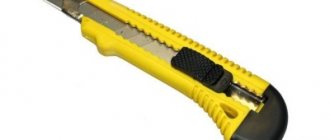Equipment for cleaning premises, including industrial ones, will always be in demand. Only its design and functionality changes. The changes are not in favor of cleaners, who are now required in production many times less, because the equipment is able to cope with large areas. Now professional cleaning companies offering quality services have appeared on the market. Until recently, a labor-intensive process now becomes easier and more enjoyable. What are the requirements for storing professional equipment today? cleaning production premises and how to choose it correctly?
What kind of cleaning is there?
Cleaning, often now called the fashionable word “cleaning,” is necessary for everyone, regardless of living and working conditions.
Every apartment, like every organization or enterprise, has cleaning equipment - be it a basic broom and dustpan or high-tech equipment. It all depends on the type of cleaning. Classification occurs according to mechanization, water use, location of cleaning and frequency. Based on mechanization, a distinction is made between manual and mechanized harvesting.
Depending on the amount of water used, there are three types of cleaning.
- Dry cleaning - removing dust with electric brushes, vacuum cleaners, sweepers or manually (rag, napkin, brush, broom).
- Wet cleaning is the removal of dirt from surfaces using a small amount of water. It is usually used after dry cleaning by spray cleaning with a spray bottle, wet mops, special wet wipes or rags.
- Wet cleaning is general cleaning using large amounts of water and disinfectants to clean floors, glass, tiles, and some types of furniture. It can be either manual or mechanized.
Cleaning can be internal and external.
- Internal cleaning is intended for residential, as well as public and industrial premises.
- External cleaning is used to clean streets, roads, parks, squares, and local areas.
The frequency of cleaning is daily, weekly, monthly and general (on demand).
Preparatory stage
Before you start working with cleaning products, take care of your own safety. Use:
- rubberized household gloves (for greater comfort, wear thin cotton mittens underneath them);
- an apron with large, roomy pockets;
- a respirator (if you plan to work with caustic, strong-smelling substances such as ammonia).
Wear comfortable shoes. Carrying out general cleaning barefoot or wearing socks is unhygienic, dangerous and inconvenient.
Kinds
Depending on the target audience of the cleaning company, you should select the necessary equipment. If this is cleaning apartments and regular cleaning of small offices, then it is enough to buy a vacuum cleaner, a good vacuum cleaner, a steam cleaner, dry cleaning, hand tools and consumables.
If the cleaning company is determined to clean large and very large objects, such as an airport, shops, large office premises, or take on entire buildings with large internal and local areas for maintenance, then they should purchase slightly different equipment. This includes industrial vacuum cleaners, powerful large vacuum cleaners, foam generators, polishers, rotary machines, floor scrubbers, tools for removing snow, including from the roof, and road cleaning equipment.
For cleaning inside small rooms, manual equipment is used. For cleaning floors over large areas, professional scrubber dryers are used, the power and productivity of which are several times higher than manual ones.
Today, technology has reached the point where large industrial machinery is connected to a GPS system so that the operation of the machine and the worker can be monitored.
Bucketless room cleaning
A way to tidy without buckets
Cleaning rooms using buckets has become a common practice. Professional cleaning companies do not forget about this method. Moreover, the method is known all over the world. It’s quite difficult to give it up, but it’s time for a change. It was replaced by a bucketless method of cleaning. These are mops mounted on a mop with or without spin. This option is common in Europe. It was invented in Finland in the 80s. Popular in medical institutions.
Bucketless cleaning process:
- Use prepared mops to wipe the required area.
- The contaminated part of the equipment is immersed in a container.
- Next, use another mop.
Mops are prepared in advance by soaking them with an antibacterial agent. Already used mops are washed and disinfected. Thus, a repeating cycle occurs. The material used for attachments should be microfiber. It absorbs dirt better and is easy to wash. The bucketless cleaning method meets the sanitary requirements established in Russia.
This method has a number of advantages:
- takes less time;
- saves money and water;
- the quality of cleaning improves;
- the cost of purchasing mops is reduced;
- A smaller staff of cleaners can cope.
Note! When choosing cleaning assistants, it is better to use battery-powered devices. Since the cable can limit the actions
In this case, the battery power must be sufficient.
Which assets include inventory?
Business inventory in accounting is objects that can relate to materials or fixed assets. This depends on two factors: their cost and useful life.
If the useful life of production and household inventory does not exceed 1 year (12 months) or if the useful life is more than a year, and the cost does not exceed the limit established in the organization’s accounting policy (but not more than 40 thousand rubles), then the inventory is taken into account as part of inventories (clause 5 of PBU 6/01). If the period of its use is more than a year, and the cost is more than the established limit, then the inventory is taken into account as part of fixed assets.
Special requirements for inventory storage
After cleaning, be sure to disinfect equipment
Storage standards for cleaning equipment depend on the place of use. There are no specific requirements at home. As for public places, in connection with sanitary and hygienic requirements there are rules for storing equipment:
- All cleaning material should be labeled and marked in a bright color.
- A separate room should be allocated for storing carts, buckets and mops. For large productions - with an area of no more than 4 square meters and a height of 1.5-2 meters.
- Washing machines for attachments and rags are located in the same room.
- After putting things in order, all equipment involved is disinfected, washed and dried.
- To clean walls and floors, use separate devices and store them separately from the rest.
- The vacuum cleaner is placed in a closed and dry cabinet.
The main recommendation for storing equipment is compliance with sanitary and hygienic requirements, as well as convenient location. Such storage rooms are available in every public institution. Strict compliance with the rules is observed in medical, restaurant, educational and other buildings.
Note! Proper use and storage of cleaning equipment will save not only time, but also costs on detergents and personnel. https://www.youtube.com/embed/zR2dpGmSPGs
Storage rules
storage rules :
- Inventory that has undergone processing is sent for storage. It should be especially careful if it was used in areas with high levels of bacterial contamination.
- All equipment must be washed and freed from water as much as possible. The rags are wrung out, the buckets are wiped with dry rags.
- A separate room should be provided for storing cleaning equipment. It’s good if there are special cabinets installed in it.
- In sanitary rooms it is desirable to have sinks and drains.
- Only marked equipment is sent for storage.
The room should be dry and clean - creating such conditions will prevent the growth of bacteria, insects and rodents.
Types of inventory
The process of putting things in order is improved and made easier every year. Even an ordinary mop no longer resembles a wooden triangle with a rag. Just like cleaning itself, equipment for it has its own classification.
Equipment for manual cleaning
The following tools are used for dry cleaning:
- scoop with long and short handles;
- broom, brush with a long or short handle (improved broom).
The advantages of the brush are its durability, and the long handle allows you not to tire your back.
For wet and wet cleaning you will need two main items.
- Bucket (plastic, galvanized, enameled). Recently, plastic buckets have been predominantly used.
- Mop – with a sponge, with a platform, wooden, rope. Mops are also available in straight and angular shapes.
Equipment for mechanical cleaning
There are two main types of equipment for dry cleaning.
- Vacuum cleaner (with a dust collector, with an aqua filter, container and cyclone vacuum cleaners without bags). Modern models are also used for wet cleaning.
- Sweeper (mechanical, battery-powered, internal combustion engine, with operator's seat).
For wet cleaning you will need the following mechanisms.
- Washing machine. Typically used for large industrial premises. The size is selected according to the area being cleaned.
- Steam generator (electric, diesel, industrial).
- Carpet cleaning machine. For dry and wet dry cleaning of pile coverings.
For kitchen
There is a whole range of the most complex contaminants and various surfaces.
The kitchen is one of the most problematic places in the house
To clean them you will need:
- sponges with an abrasive layer;
- steel wool;
- melamine sponge;
- ceramic scraper;
- brushes and brushes for washing dishes, stoves, ventilation grilles;
- soft rags.
Correct selection
Sweepers
When choosing cleaning equipment, you need to base it on the following factors:
- room area;
- amount of pollution.
In warehouses, industrial workshops, and shopping centers, special cleaning equipment is used, which has a wide range of capabilities and small dimensions. This is necessary in order not to disturb the silence during working hours, and also not to clutter the aisles. Office rooms need simple equipment: a mop, a rag, a vacuum cleaner and antibacterial liquid. Cleaning in hotels has been improved with equipment and cleaning products. The required cleaning kit includes:
- Wipes made using nanotechnology for cleaning any type of surface.
- Microfiber cloths with spin system.
- Bucket cart with wheels. Consists of a carriage containing 2 containers. One is intended for squeezing the mop, the second contains the solution. In addition there are compartments for storing additional tools.
- When cleaning public properties, disposable wipes are often used.
Equipment for cleaning premises is necessary in public institutions: gardens, clinics, catering establishments. This is due to increased sanitary and hygienic requirements.
Important! A lot of useful equipment has been developed for cleaning. Consultants in specialized stores will help you understand their purpose.
Main categories of professional cleaning equipment
As noted, the classification of cleaning equipment is carried out on the basis of the tasks and purposes that such tools and equipment solve. In particular, only cleaning agents are purchased for wiping glass, and specialized compounds are purchased for disinfection. Among modern equipment there are professional equipment and tools that solve strictly defined problems. Such products are used for cleaning premises with increased requirements for cleanliness.
Also, the gradation of professional equipment is carried out taking into account the frequency and nature of cleaning. Similar products are available for everyday, special, multi-purpose and other cleaning. Therefore, inventory requirements vary depending on the type of classification used.
Special equipment
Regardless of the type of equipment, the following requirements apply to special cleaning equipment:
- high performance;
- strength;
- reliability;
- long service life.
Also, such equipment should not damage furniture during the cleaning process. For cleaning residential premises, it is recommended to purchase equipment that does not make noise during operation.
Special cleaning equipment is divided into the following types:
- vacuum cleaners for dry cleaning;
- dust extractors;
- carpet cleaners (carpet washers);
- floor polishers (single-disc machines);
- sweepers and others.
Vacuum cleaners are used to clean carpets, rugs, upholstered furniture and other items from dust and debris. These devices are complemented by various attachments, each of which performs a specific function. Vacuum cleaners are used for everyday cleaning.
Vacuum cleaners are designed to remove difficult to remove stains. These devices are ways to collect wet waste. To clean carpets, specialized extractors are used that remove dirt using detergents. Scrubber dryers have been created for cleaning floors. Some types of this equipment are capable of sweeping even surfaces. To finish floors, floor polishers are used to apply wax or polish the surfaces.
Household goods
The group of household goods includes:
- mops;
- window cleaning brushes;
- gloves and cleaning material;
- napkins (microfiber and other materials);
- sponges;
- brushes and more.
The group of household goods includes attachments for mops and other devices for cleaning premises. The above equipment is divided into separate groups depending on the area of application.
Buckets, press-ups
Buckets and means for squeezing are classified as household goods according to a number of classifications. Such products are made of durable plastic that can withstand repeated and long-term use. Buckets and squeezes are also divided into more than one group.
For cleaning windows
For cleaning windows use:
- sponge for applying cleaning agent;
- tool for removing the solution;
- telescopic handle.
These products are included in the standard set of window cleaning equipment. Also in this case, microfiber cloths and other similar products are used.
For cleaning premises
The group of equipment intended for cleaning premises consists of the previously mentioned products. Specialized equipment is used mainly for cleaning interior rooms and corridors. This is due to the fact that professional cleaning (if carried out regularly) takes a lot of time. But, unlike the other cases considered, you can’t do without household goods and hand tools to clean the premises.
For cleaning areas
For cleaning areas, specialized equipment such as sweepers is mainly used. Hand tools in this case are used to clean a small area.
Professional chemistry
This group includes a variety of cleaning products designed for cleaning carpets, furniture, and so on. Professional chemistry is used to remove complex, simple and specific stains (from coffee, tea and others).
Other
To make cleaning easier, use:
- stepladders;
- stepladders;
- platform stepladders.
If necessary, after cleaning, use surface polishing and waxing products. A separate group includes equipment designed for cleaning escalators and stairs.

